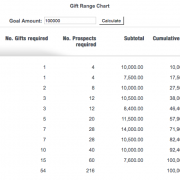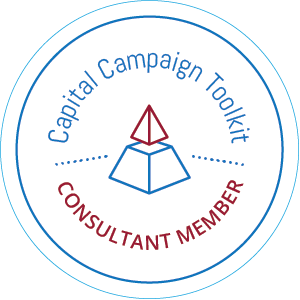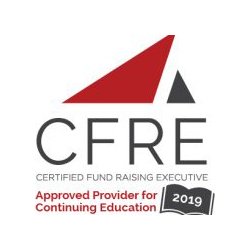One might think that gift range charts are just for large projects such as capital campaigns or for significant fundraising efforts. And, while, yes, there is some truth to that, gift range charts can be used effectively in even the smallest of fundraising shops.
A gift range chart will tell you exactly how many gifts AND prospects you need at each giving level to reach your goal. And, it also shows you the potential to reach your fundraising goal.
So, first, how do you create one?
- Well, you can use any online calculator to do so. I highly recommend the simple and easy to use Blackbaud gift range calculator. You can find that tool here.
- A gift range chart calculator is only going to provide you with an estimate. If you want to be more accurate, you may want to create the chart on your own using the given realities of your organization. So, how do you go about creating your own? Well, you will want to identify the highest level gift to your fundraising efforts. That will probably be somewhere in the area of 20% of goal. Estimate 3-5 prospective donors per gift. Fill in your chart downwards based on what you know about your donors and their capacity. Gift amounts go down, and the number of donors increases.
So, here is what a $100,000 fundraising goal would look like: https://www.blackbaud.com/nonprofit-resources/gift-range-calculator

How do you now use this information to inform your strategy?
- I would first look at the top gifts needed. Here in this example, you would need 1 – $10K, 1 – 7.5K, 2 – $5K, and 3 – $3.5K for a total of $38K. There are several options, right? You could write several grants. In this case, you would need 28 grant possibilities, or you could approach a few major donors.
- Then if you look at your next tier of gifts, you would need $34K in gifts. Perhaps you have a fundraising event, or maybe a direct mail campaign or a series of direct mail campaigns. Or perhaps you continue to ask for gifts at this level.
- Maybe you look even further down and realize that you have a series of direct mail appeals, or that one appeal will do it for the remainder of the $28K or so.
The fact of the matter is that any possibility of a strategy will work, as long as it is realistic and fits for your organization. The key thing to remember is that you want to secure the top gifts first. If you don’t raise those, then you need to readjust all the lower levels of the gift range chart below to “make up” for the difference.
Then, you can use this gift range chart as a monitoring and reporting tool. Let’s say that you are not hitting your “lead” gift targets. Well, you can certainly adjust this gift range chart mid-course and make the necessary adjustments to your strategy BEFORE your fundraising efforts get too far off track. And, this would be a great tool to share with your Board of Directors to educate them on the process of raising money and how your particular efforts are progressing towards projections.
So, though you may think that gift range charts are for the “big shops,” think again, a gift range chart can provide even the smallest campaign with focus and goals based on actualities and realities.
So, this next fiscal year why don’t you first start by creating a realistic gift range chart for your annual fund campaign and develop strategies to get you to your goal.






